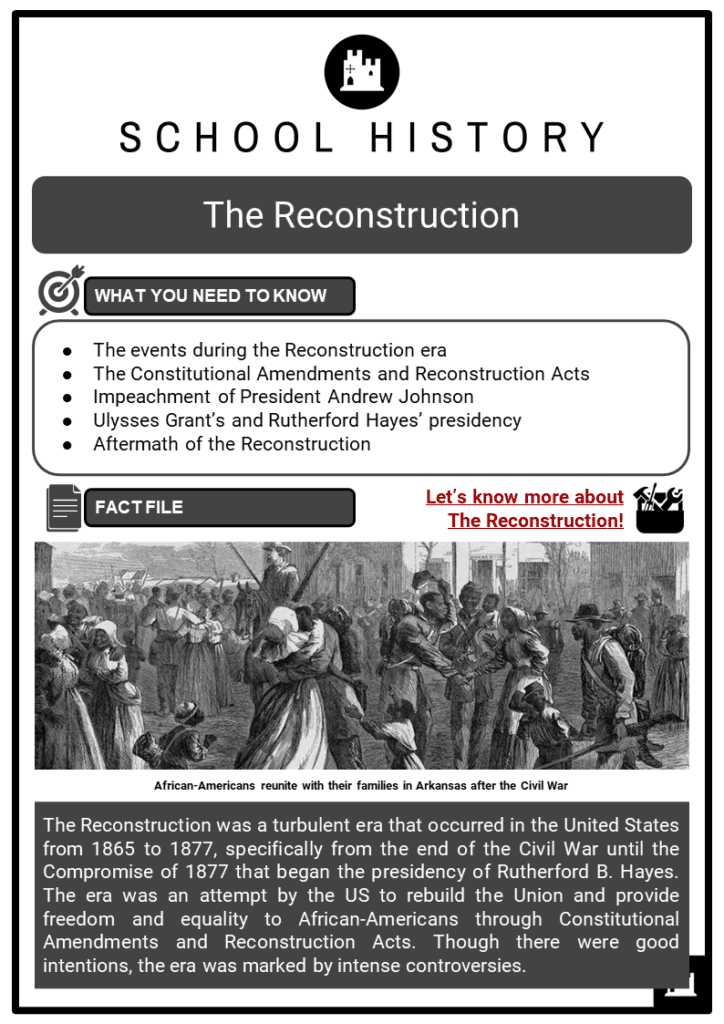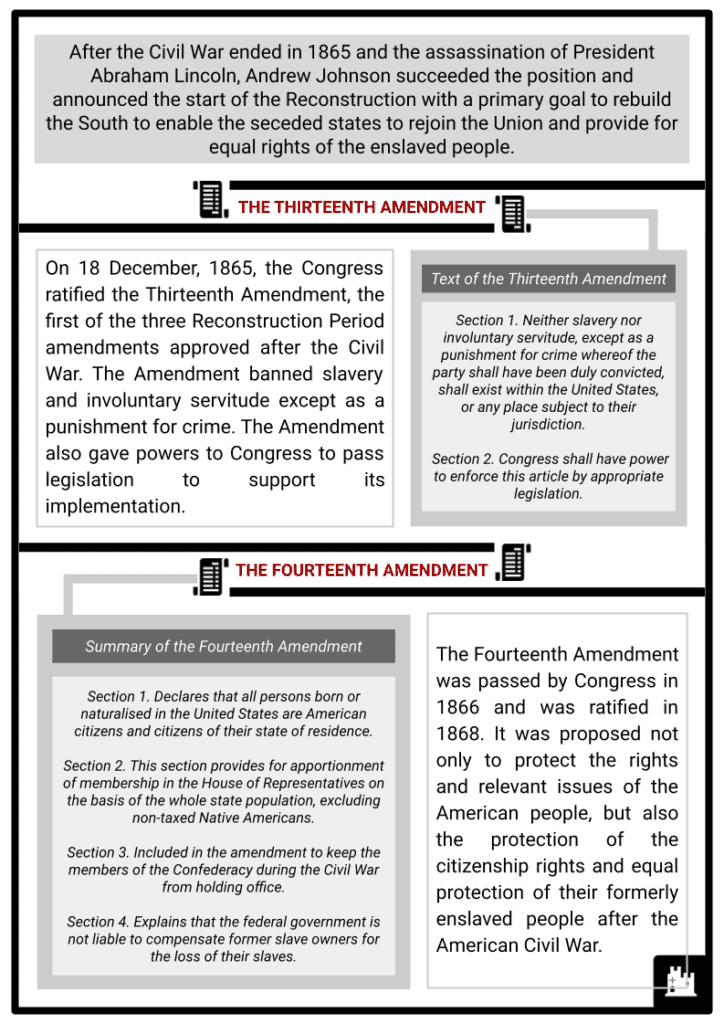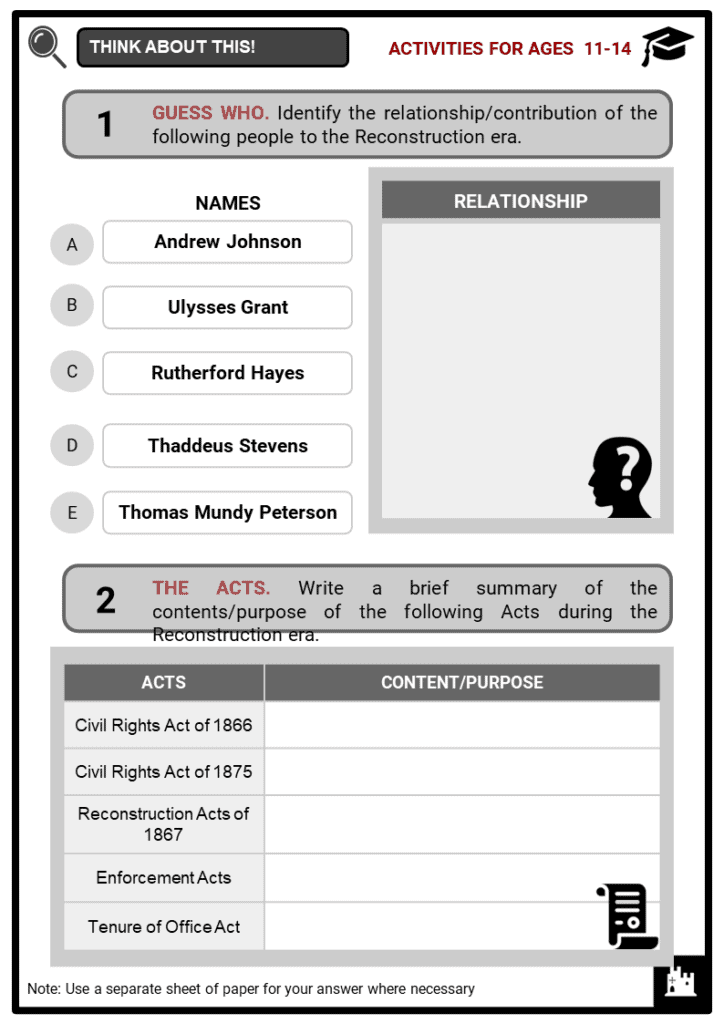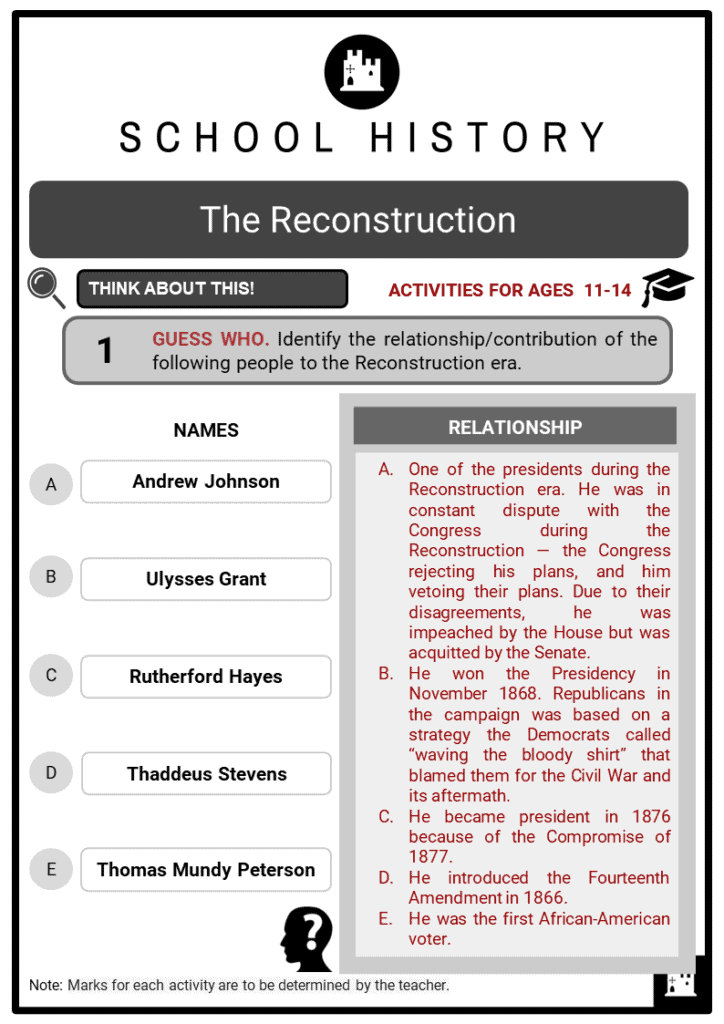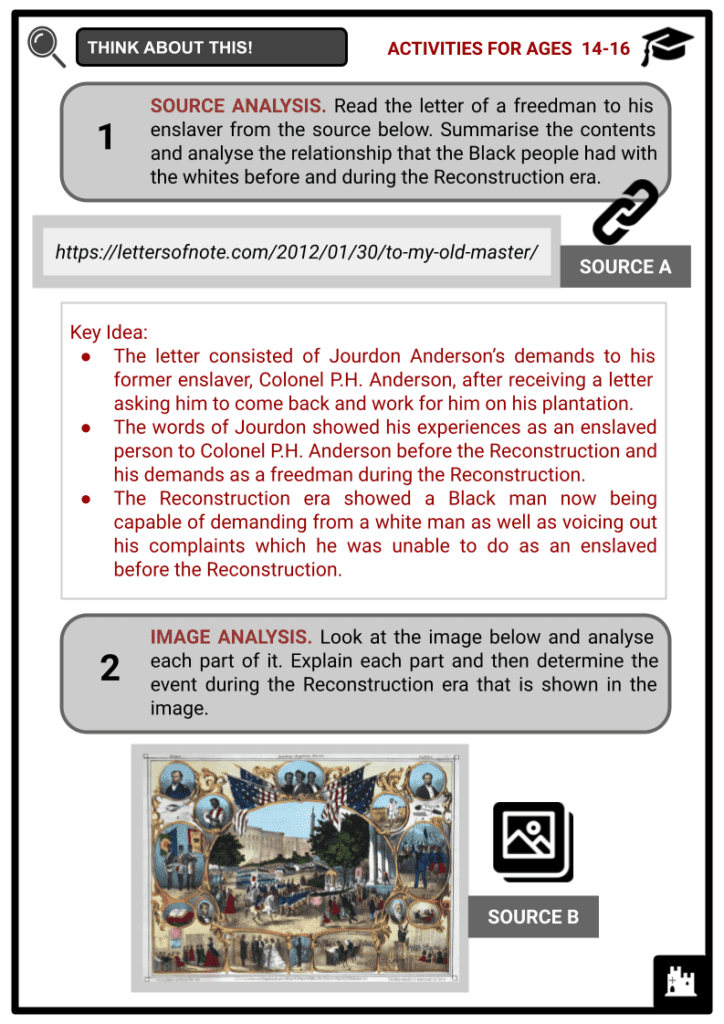Download The Reconstruction Worksheets
Do you want to save dozens of hours in time? Get your evenings and weekends back? Be able to teach The Reconstruction to your students?
Our worksheet bundle includes a fact file and printable worksheets and student activities. Perfect for both the classroom and homeschooling!
Table of Contents
Add a header to begin generating the table of contents
Summary
- The events during the Reconstruction era
- The Constitutional Amendments and Reconstruction Acts
- Impeachment of President Andrew Johnson
- Ulysses Grant’s and Rutherford Hayes’ presidency
- Aftermath of the Reconstruction
Key Facts And Information
Let’s know more about The Reconstruction!
- The Reconstruction was a turbulent era that occurred in the United States from 1865 to 1877, specifically from the end of the Civil War until the Compromise of 1877 that began the presidency of Rutherford B. Hayes. The era was an attempt by the US to rebuild the Union and provide freedom and equality to African-Americans through Constitutional Amendments and Reconstruction Acts. Though there were good intentions, the era was marked by intense controversies.
- After the Civil War ended in 1865 and the assassination of President Abraham Lincoln, Andrew Johnson succeeded the position and announced the start of the Reconstruction with a primary goal to rebuild the South to enable the seceded states to rejoin the Union and provide for equal rights of the enslaved people.
The Thirteenth Amendment
- On 18 December 1865, Congress ratified the Thirteenth Amendment, the first of the three Reconstruction Period amendments approved after the Civil War. The Amendment banned slavery and involuntary servitude except as a punishment for crime. The Amendment also gave powers to Congress to pass legislation to support its implementation.
- Text of the Thirteenth Amendment
- Section 1. Neither slavery nor involuntary servitude, except as a punishment for crime whereof the party shall have been duly convicted, shall exist within the United States, or any place subject to their jurisdiction.
- Section 2. Congress shall have power to enforce this article by appropriate legislation.
The Fourteenth Amendment
- The Fourteenth Amendment was passed by Congress in 1866 and was ratified in 1868. It was proposed not only to protect the rights and relevant issues of the American people, but also the protection of the citizenship rights and equal protection of their formerly enslaved people after the American Civil War.
- Summary of the Fourteenth Amendment
- Section 1. Declares that all persons born or naturalised in the United States are American citizens and citizens of their state of residence.
- Section 2. This section provides for apportionment of membership in the House of Representatives on the basis of the whole state population, excluding non-taxed Native Americans.
- Section 3. Included in the amendment to keep the members of the Confederacy during the Civil War from holding office.
- Section 4. Explains that the federal government is not liable to compensate former enslavers for the loss of their enslaved people.
- Thaddeus Stevens, a member of the House of Representatives introduced the Amendment.
- It squashed the Dred Scott of 1857 which provided that black people were not eligible for citizenship.
- The Dred Scott Case (also known as Dred Scott v. Sanford) confirmed the legality of slavery in the Southern states and the westward expansion, but the abolitionist movement convinced the Southerners that the North was bent on dismantling the institution of slavery. The case that lasted a decade was mainly about the freedom of an enslaved African named Dred Scott.
Civil Rights Act Of 1866 And 1875
- The Black Codes, a series of laws that undermined the freedom and civil rights of African-Americans, caused widespread resistance among African-Americans in the South.
- The Northern states argued that the laws undermined the principles of free labour.
- Because of this, the Civil Rights Act of 1866 was enacted with the purpose of preserving the Black community’s rights.
- Despite the attempt to integrate formerly enslaved within society, however, the Civil Rights Act of 1866 did not have much success and ‘failed to protect’ the African-Americans against segregation, racism and intimidation (African-American Civil Rights Movement, no date).
- The Civil Rights Act of 1875 was the last major Reconstruction act that guaranteed to protect African-Americans’ civil and legal rights.
- The Act provided for equal treatment regarding public transport, public accommodation and jury service.
- The Civil Rights Movement was a decade-long struggle by African-Americans to end racial segregation, disenfranchisement and discrimination in the United States.
- After 8 years of effectivity, the Civil Rights Act of 1875 was deemed unconstitutional in 1883.
- The Act had little practical impact. Despite this, many provisions from the Act were adopted by Congress during the Civil Rights Movement.
The Reconstruction Acts Of 1867
- Four Statutes of the Reconstruction Acts of 1867
- Participation in Constitutional Conventions
- Regardless of race, all males (excluding former Confederate leaders), were permitted to participate in the constitutional conventions that formed the new governments in each state.
- Ratification of the 14th Amendment
- Former Confederate states were required to ratify the 14th Amendment which states that “All persons born or naturalized in the United States... are citizens of the United States.” It also guarantees “no state shall ... deny to any person within its jurisdiction the equal protection of the laws.”
- New State Constitutions
- The former Confederate states would need to create new state constitutions providing universal male suffrage, disregarding race.
- Military Districts
- The South would be divided into five military districts, each governed by a military governor. These five military districts were: (1) Virginia, (2) North Carolina and South Carolina, (3) Georgia, Alabama and Florida (4) Mississippi and Arkansas; and (5) Louisiana and Texas.
- Johnson was a firm believer in states’ rights and therefore sought not to interfere with state affairs beyond what he felt was the constitutional requirement.
- This included not interfering with the voting process and requirements.
- He took a very lenient position during the Reconstruction and was keen on affirming the rights of the states over the issue of slavery as was the case before the war.
- The war tensions between the North and South were rife after the Civil War.
- Persons travelling from the North to the South after the Civil War to help the Black people and profit from the Reconstruction were called carpetbaggers.
- The white Southerners working with the northern Republicans during the Reconstruction were called Scalawags.
- Radical Republicans, however, were keen on ensuring that African-American rights were realised. Congress, therefore, enacted the Reconstruction Acts of 1867, overriding a veto by President Johnson.
- It consisted of four statutes that address the requirements of the seceded states (in order to be readmitted to the Union) and the security of the rights of African-Americans.
Impeachment Of President Johnson
- The journalist William McCardle was arrested for treason after criticising Congress and a Union military commander.
- His defence was that the Reconstruction measures, including military occupation in the South, were unconstitutional.
- He appealed to the U.S. Supreme Court, taking advantage of the recently passed Habeas Corpus Act of 1867 which was an Act to enable African-Americans to access the Supreme Court in the event federal governments and courts violated their constitutional rights.
- Congress, fearing that the Supreme Court would agree with McCardle, passed another measure that suspended the right of the Supreme Court to subject Reconstruction measures under Judicial Review.
- Johnson vetoed the bill, but Congress once again overrode his veto.
- The Supreme Court dismissed the case on the grounds of lack of jurisdiction years after.
- Congress was unhappy with Johnson’s insistence on vetoing Congress measures.
- His racist and white supremacists’ remarks during the December 1867 State of the Union address further aggravated his relationship with Congress.
- In August 1867, President Johnson removed the Secretary of War — Edwin M. Stanton — without the approval of Congress.
- He attempted to replace Stanton with Ulysses S. Grant, but Grant resigned from the position as he was in support of the Reconstruction measures.
- The Republican welcomed the president’s actions and was impeached in February 1868 on the grounds of violating the Tenure of Office Act.
- In the impeachment proceedings in which the House of Representatives serves as the prosecution and the Senate as the judge, eleven counts of encroaching on Congress’ powers were brought against Johnson.
- In the final vote, the Republicans failed to reach the required two-thirds majority.
- Johnson survived, and the Republicans dropped the endeavour, but the president was effectively silenced.
Grant’s Presidency And The Fifteenth Amendment
- Ulysses S. Grant won the Presidency in November 1868.
- The success of the Republicans in the campaign was based on a strategy the Democrats called “waving the bloody shirt” that blamed them for the Civil War and its aftermath.
- Text of the Fifteenth Amendment
- Section 1.
- The right of citizens of the United States to vote shall not be denied or abridged by the United States or by any state on account of race, color, or previous condition of servitude.
- Section 2.
- The Congress shall have power to enforce this article by appropriate legislation.
- Grant allowed for the continuation of the Reconstruction agenda.
- In 1869, the Republicans introduced the Fifteenth Amendment which was ratified in 1870.
- The Amendment granted universal male suffrage to African-Americans and gave Congress the power to enact legislation for the proper implementation of the Amendment.
- With this came the first African-American vote on 31 March 1870, by Thomas Mundy Peterson.
- In 1871, Grant’s administration passed the Enforcement Acts with the aim of controlling the violent actions of the Ku Klux Klan.
- Support for the Reconstruction greatly diminished over the years and in 1874, after economic depression and elections, the Democrats — for the first time since the Civil War — had control over the House of Representatives.
- The Ku Klux Klan (also called KKK or Klan) is the oldest white supremacists’ terrorist organisation and American hate group that became prominent during the Reconstruction era. It was founded in 1866 and by 1870, had spread to most of the Southern states as a resistance mob against Reconstruction policies.
Effects of the Reconstruction Amendments
- Effects of the Thirteenth Amendment
- The eradication of slavery was quickly felt by many.
- The Post Reconstruction Black Codes and Jim Crow Laws continued to take effect.
- It made the Fugitive Slave Clause and Three-Fifths Compromise ineffective
- Even if the amendment effectively terminated slavery, there were still discriminatory measures being observed.
- In Delaware, 900 people were legally freed and a lot of enslaved people escaped during the war.
- In Kentucky, enslaved people were freed, but only 65,000 – 100,000 people remained legally liberated.
- Effects of the Fourteenth Amendment
- States could no longer pass laws denying citizens’ equality.
- It allowed the national government to protect the citizens from dangerous actions of the State governments.
- The minority class has been granted rights and privileges that are enjoyed by a citizen.
- Private right, however, did not exist and was never recognised during the Reconstruction era.
- It had a great impact on education, especially on Black people who have long been deprived of attaining knowledge.
- Effects of the Fourteenth Amendment
- African-Americans in the US were not immediately able to vote.
- Poll taxes were observed to keep African-Americans from voting.
- White people were exempt from voting tax because of the “grandfather clause”, which explains that if their grandfather voted in the last election, they didn’t have to pay the fee.
- People in the South used different methods to prevent African-Americans from voting.
- Literacy tests were also done to prevent African-American people from voting.
- Intimidation was also used to keep them from voting and this resulted in violence.
Hayes’ Presidency, Compromise of 1877, And Reconstruction Aftermath
- In 1876, Rutherford B. Hayes became president in one of the most contentious elections in United States history.
- During the popular vote, Hayes lost to Democrat Samuel J. Tilden.
- Rutherford, however, turned the tables when he won the intensely disputed electoral-college vote. The Congressional commission awarded him twenty contested electoral votes.
- His victory was because of a compromise he had reached with the Democrats.
- The compromise, known as the Compromise of 1877, reached an agreement with the Democrats that in exchange for allowing his declaration as the winner in the election, he would acknowledge the Democrats to control the entire South.
- The root of the Compromise looked more like a truce with the South rather than a compromise; thus, it signalled the end of the Republican Party’s commitment to protecting the rights of African-Americans.
- With the withdrawal of the federal troops after the compromise, any hope of reconstructing the South into a racially-egalitarian society had ended, signalling the end of the Reconstruction era.
- However, though the compromise ended the Reconstruction, its legacy would be revived a century later with the Civil Rights movement.
- The end of the Reconstruction ushered the Jim Crows laws and the Black Codes that significantly undermined the Constitutional safeguards that African-Americans had celebrated with the Reconstruction Act and the Constitutional Amendments.
Image sources:

